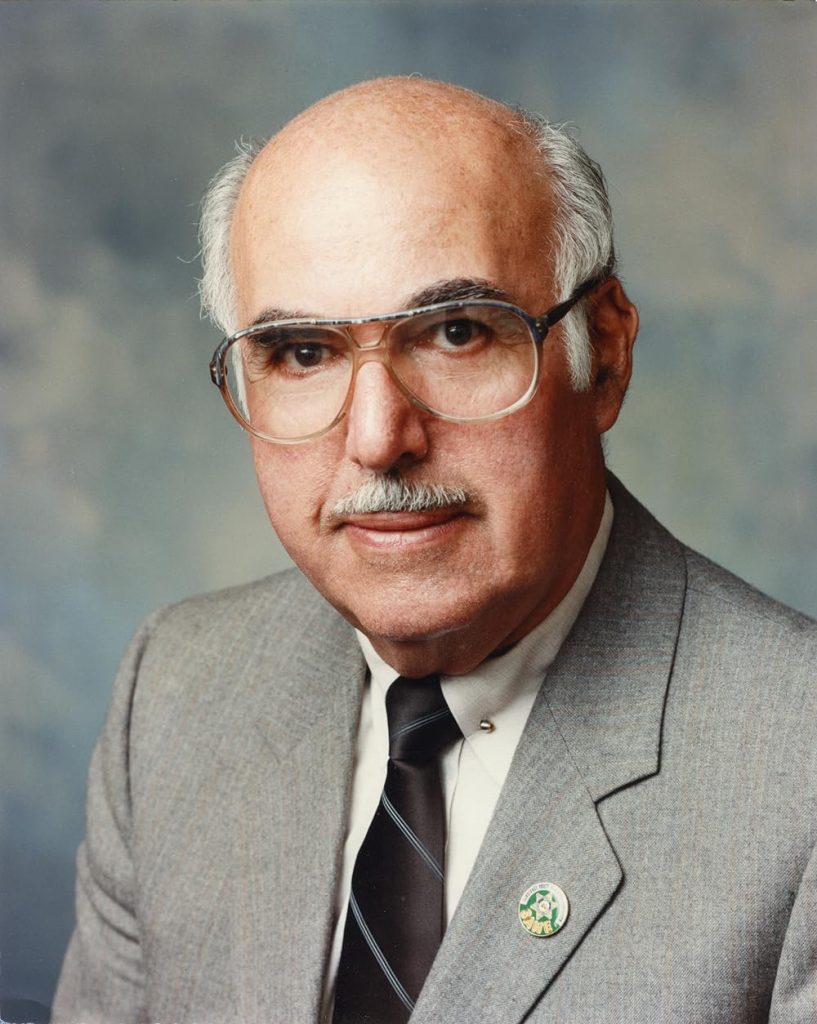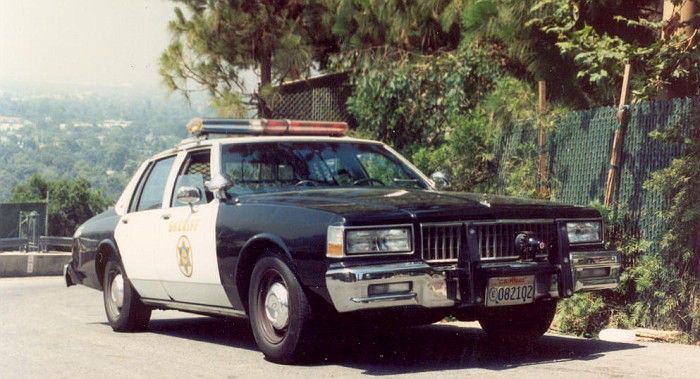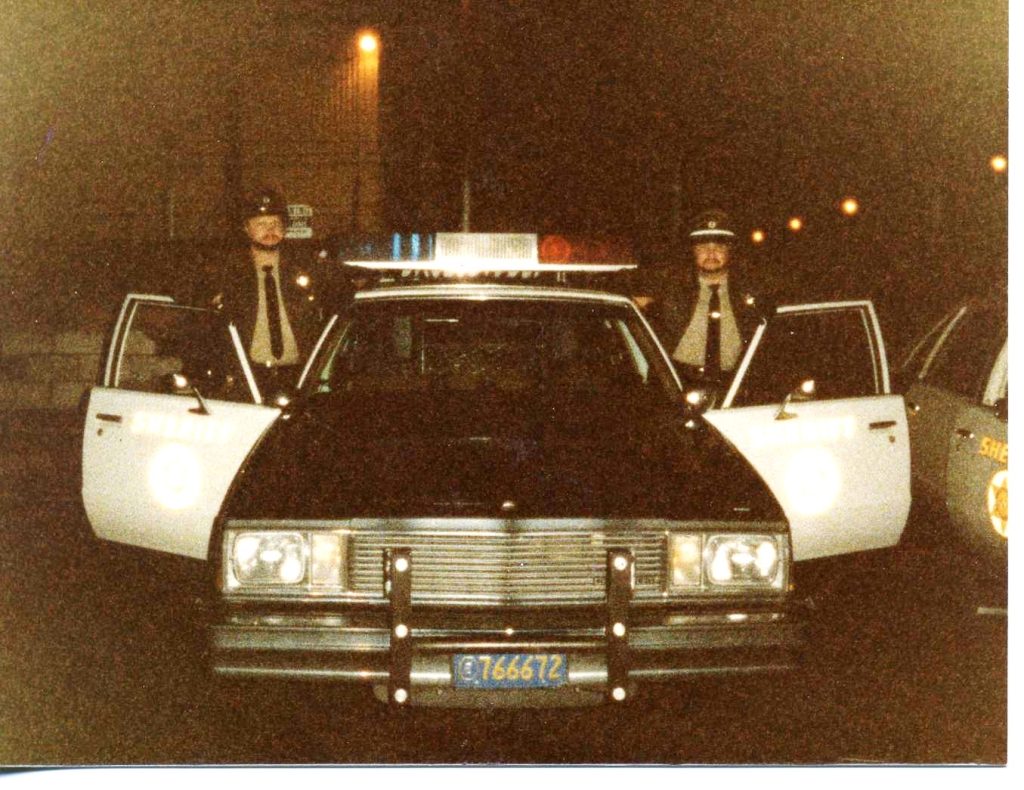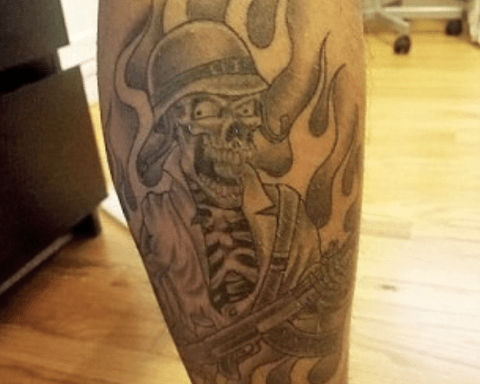The following article is #1 in a series of real-life experiences taken from the manuscript of retired LASD Deputy Dale Hedges, titled, “Damage Control,” which documents his time with the Los Angeles County Sheriff’s Department.
I am dedicating this series to my partners at the Los Angeles County Sheriff’s Department’s North Regional Surveillance and Apprehension Team (NORSAT). Special dedication to my NORSAT partner, Deputy Sylvia Smith, may she rest in peace. I am also dedicating this effort to a victim of the corruption by the Los Angeles County Sheriff’s Department, the inspiration for this story and a friend, Deputy Brian Wines. Without their help, inspiration and sacrifices this story would never have been made public. A special thank you to retired LASD Captain Mike Bornman, without whose help this series would never have been published.
This series is based on true events within the Los Angeles County Sheriff’s Department, primarily between the years of 1977 and 1997, although some names and events may have been altered to protect individual deputies and those who may not have been prosecuted. This is a story of the dedication and comradery shared by the deputies of the Los Angeles County Sheriff’s Department. It’s a story about corruption, power, and abuse of that power by several top administrators of the Los Angeles County Sheriff’s Department at that time, the Sheriff of Los Angeles County, Sherman Block and his second in command, Undersheriff Jerry Harper.

Their willingness and complicity of those at the highest ranks, to protect and allow to go unchecked, the head of Psychological Services Bureau (PSB) and those who served in that division was astonishing. When they had undisputable firsthand knowledge and proof that those within the highest ranks of Psychological Services were directly responsible for the deaths by suicides of at least six deputy sheriffs at the hands of a criminal ex-deputy sheriff, hired and disguised as a Doctor of Psychology.
This is about a Sheriff, an elected official, along with his Undersheriff who knowingly allowed this malfeasance to go unpunished. They then impeded an investigation, intentionally allowing those suicides, as well as crimes against other victims, to go unprosecuted and hidden to protect their own jobs, political careers and reputations, along with protecting the reputation Psychological Services Bureau and Director of PSB at the time, Doctor Audrey Honig.
This was criminal conduct at its worst, and the events have never stopped haunting me over the years. This series is a factual true story of the leadership and conscious decisions made by a power hungry, corrupt Sheriff and Undersheriff, among others, and the physical and emotional price they forced many deputies to unknowingly suffer under their corrupt administration, which is almost incomprehensible. All done in the name of “Damage Control.”
THE IMPOSTER
I had been at NORSAT unit for just over a year, when on New Year’s morning 1992, at about 6am, the phone rang. I had the holiday day off from my unit at NORSAT and I had gone downstairs and turned on the TV early while I waited for my two daughters to come down to watch the Pasadena Rose Parade with me. When I answered the phone, my unit Commander, Lieutenant Clark was on the other end. He requested that I respond immediately to the Crescenta Valley Sheriff’s Station in La Canada.

Lieutenant Clark advised me of an arrest that had been made at the Rose Parade early that morning of a male suspect impersonating a Los Angeles County deputy sheriff. He did not have many details except to tell me the request had come directly from Sheriff Block, who had concerns about the suspect’s motives and the possibility of involving other people and/or a conspiracy to taint the Sheriff’s Department. I got ready, said goodbye to my two daughters, and drove to the Crescenta Valley Station to interview the suspect and begin the investigation.
Once at the station, the suspect, Leymoine Bolton, was moved into an interview room. I began searching for his arrest history in the computer system. I found he was a fugitive from justice, an escapee from a California State parolee halfway house back in November of 1989, where he had been paroled from prison after serving time for forgery. Once in the interview room, I found Bolton calm and oddly friendly. After reading him his rights, he stated he knew he was already going to be returned to prison, he was surprised he had managed to stay out without getting caught as long as he had. He waived his rights and said he was willing to discuss the incident and his arrest at the Rose Parade with me. I had with me at the interview the uniform, badge, leather gear and holster he had worn at the time of his arrest. I had many questions for him.
Looking at the badge he had worn on his uniform shirt, I could see it was an actual Los Angeles County deputy’s “flat badge”. This badge would have normally been kept inside a wallet with a Sheriff’s picture identification card, but this badge was altered. The badge had been removed from the wallet. The metal points of the star had been bent or curved back to resemble a curved breast or uniform badge. On the back, it had a large safety pin attached, which had been hot glued onto the badge to allow it to be worn or pinned on a uniform shirt. I asked where he got the badge and what he was doing with it. He then began the lengthy story leading up to his arrest.
Bolton began by telling me he regretted his decision and felt stupid for getting caught at the Rose Parade. He said his entire life he had always desired to be a law enforcement officer, especially a deputy sheriff. Although he knew he could never get the job because he was a felon and ex-convict, he loved cops. His chances of ever being hired were taken away when he was arrested and eventually went to prison for other crimes, but his desire was still there. After he was paroled, he was released to a supervised halfway house. In 1989 he decided to get out of the house. He left the home knowing he would be violating his parole and would eventually be arrested for escaping the facility but decided to risk it and move on with his life.

Bolton said after leaving the halfway house he had begun looking for work and had lied on an employment application. He managed to get himself a job as a Group Home Manager for a Los Angeles County group home for abused children. While there he was introduced to a new counselor who had recently arrived at the home, a man he met and knew by the name of August Hoffman, who said he said was a psychiatrist. Bolton couldn’t help but notice when he arrived for work that there was a clean, crisp Los Angeles County Sheriff’s deputy uniform hanging in the back window of Hoffman’s car for all to see. The uniforms were there every day. Intrigued and curious, Bolton decided to ask Hoffman about them.
Hoffman claimed at first that he was a retired deputy sheriff and later claimed to have the uniforms because he was still an active reserve deputy sheriff. He then proudly pulled out this flat badge and ID card, showing it to Bolton to prove his point. Bolton said after they had that conversation, he noticed that Hoffman would often and intentionally leave the badge and identification in its leather wallet, open and lying around the halfway house for anyone to see and find. Of course, he thought it odd and noticed Hoffman seemed to love the attention he received when it was returned to him by the young residents who found it.
Bolton noticed the wallet lying out one day and was able to get a closer look at the credentials. Seeing the badge and Identification up-close, Bolton noticed it said neither retired nor reserve. He immediately surmised that something wasn’t right with Hoffman’s story. He wondered if August Hoffman had a badge and identification he had stolen or had never turned in. Hoffman, he thought, may have been a full-time deputy at one time, but he could see the badge did not say Reserve or Retired. Hoffman worked at the home full time so he clearly couldn’t be a full-time regular Deputy. Bolton began to believe and assumed the badge may have been stolen by Hoffman.
Maybe Hoffman had been fired or quit and kept the badge. Bolton noticed over the next few weeks that Hoffman loved telling the kids any chance he got that he was working patrol and telling odd but obviously made-up war stories of events he was involved in on the street. Hoffman continued to leave his flat badge and identification lying around, open, acting as if it was simply misplaced around the house for the kids to find and return to him. Hoffman was a big shot.
For Bolton, whose lifelong desire was to be a cop, owning a real sheriff’s badge was the answer to his ultimate fantasy. Bolton decided that after being laughed at and taunted for years by his friends for wanting to be a deputy sheriff, he needed to use this badge to prove to his friends that he was finally somebody, a real deputy. So, Bolton waited patiently for the right opportunity. When Hoffman left the wallet with the badge and identification in the kitchen one morning, Bolton took it and hid it for a few days outside the house in some bushes. Hoffman became frantic and looked for it for days asking everyone if they had seen or found it, until he finally stopped mentioning it, giving up his search. Bolton felt sure Hoffman could not report the badge stolen and had finally given up his search.
Bolton then escaped from the facility and had safely gotten the badge off the property. A few days later, when he felt sure he had gotten away with the theft, he went on a binge searching for and buying sheriff’s uniforms and web gear. He purchased a used basket weave style Sam Brown belt first. It had a holster attached, but Bolton didn’t own a gun, so he wasn’t sure what kind of gun the holster was made for. He asked around and finally found someone who would sell him a gun, a revolver. He bought the revolver not realizing it didn’t fit properly into the holster on his Sam Brown. But he wasn’t sure exactly what he was going to do with all this gear yet, so he wasn’t concerned.
Bolton then drove to a uniform shop and nervously purchased a full uniform, brand new with patches included. With no questions asked, he was on his way, now he had it all. He adjusted the flat badge, bending back the points of the stars to resemble an actual breast badge. He decided to hot glue a large safety pin onto the back of the badge so it would attach and hang properly on his shirt when he wore the uniform.
The new uniform looked very impressive, so he decided to try it out and wear it in front of his friends. He showed it off to see if they would be convinced that he was indeed hired by the Sheriff’s Department and was a real deputy sheriff. He dressed up and showed up to a gathering where he told them he was working at the Los Angeles County Jail. Most of his friends were simply confused and not sure whether to believe him or not, but he did have the badge and uniform. Some of his friends were simply not convinced because of his criminal past so he was always looking for a way to convince them.
Bolton said although he was worried about getting caught, that he often wore the badge, gun and uniform while driving around town in his personal vehicle. He started out simply waving at deputies in their black and white patrol vehicles or waving to children on the streets as he drove past them. They always waved back and never bothered to stop or talk to him, so he became more emboldened, he was getting away with this and it had become addictive. He decided one afternoon to stop a group of young teens, confronting them about throwing some trash onto the ground.
Bolton said that although he was in his own personal vehicle, a small foreign car, no one ever questioned him. He was careful not to go overboard and managed to keep things friendly, not to raise suspicion or get caught. He continued to stop people on the streets, mostly women or children. He began to write their names and addresses into a notebook like a real deputy, then released them with a warning. He got away with it over and over and it became a huge rush for him. He said it made him feel important and he felt powerful. Oddly enough, he also thought he could justify his actions by believing in some way, he was doing the Sheriff’s Department a good community relations service by being so cool and professional.
As Bolton got more comfortable with his deception, he began taking things to the next level. He started pulling up alongside vehicles while in the uniform, still generally cars with young teens or lone female drivers, ordering them to pull over. He then exited his personal vehicle and approached their vehicles, telling them they had committed a violation of some sort, admonishing them about the infraction then telling them he was not going to ticket or arrest them but give them a warning.
He continued this more often over several months, until one afternoon he said he got freaked out when the female driver he pulled over seemed a little upset with him. In fact, she seemed to be a little suspicious of him. She asked him several times if he had a business card and what station he worked at. She then produced the business card of a deputy sheriff, that of her husband, an actual deputy who worked the Altadena Sheriff’s Station within the jurisdiction he was stopping her. She asked if he knew her husband. Bolton felt a hot rush go through his body and thought this was going to go badly for him. He felt sick, thought this was the one he was going to get caught doing. He wanted to stop and end the situation, he wanted to let her go quickly and get out of the area. It was a close call to him, and he decided to stop pulling people over and interacting like this.
Bolton was still looking for a way to unequivocally once and for all convince his friends he was a real deputy and realized the Rose Parade was coming up in another month. Bolton decided that the Rose Parade was going to be the ultimate way to prove it. If he could show up at the Rose Parade looking like he was working on Colorado Boulevard in uniform with other real deputies at the famous Rose Parade, they would have to believe him, but how to do it was the problem.
On December 31st, the last day of 1991, New Years Eve, Bolton began looking for the Rose Parade Command Center of the Los Angeles County Sheriff’s Department. He happened to see a personal vehicle with two deputies in uniform driving on Colorado Boulevard. He followed their car to a parking garage where he saw deputies who were working the parade pulling in. Leymoine followed them inside the structure and parked. With no clue of what to do or where to go next, and hoping he was at the right place, Bolton said he followed groups of uniformed deputies into a city building. Inside is where he located the Sheriff’s Command Center, where deputies lined up at tables and began filling out paperwork for their assignments and paid overtime.
Following their lead and not having a clue as to what he was doing, he got in line. Bolton began filling out the paperwork on a table, filling in his name, unit of assignment and other required and obvious information. But when he got to a place with six little boxes to write his individual employee number, he had no idea what to use. Trying to figure out what to write he thought it must be a spot for a badge number, so he simply entered four numbers on his stolen badge. He then followed the deputies to a large table where he handed his paperwork to a civilian clerk behind the table. She looked at his form and asked him for his full employee number and he repeated his four-digit badge number. She told him his employee number was a six-digit number, not four digits.
Although he was still confused and becoming nervous, Bolton simply added two random numbers to the four he had written down. She accepted his form, placing it on a pile of other papers. She said she did not see his name on a roster or an assignment. So, since she could not find him assigned anywhere at the parade, she gave him an assignment and quickly instructed him where to report, telling him he was working for Sergeant Bobby Olmstead. Bolton couldn’t believe his luck, he got an assignment, he was elated. He couldn’t believe he was assigned a position as a real working deputy sheriff. At this time most deputies had been issued the Beretta Model 92F, 9mm Pistol. Bolton was carrying a .38 caliber revolver inside a holster meant for a 9mm firearm. The revolver did not fit the holster correctly and could not even be properly secured or strapped into the holster. Bolton didn’t know this fact, and no one had noticed yet. Bolton was assigned his position and began to work on Colorado Boulevard alongside a group of deputy sheriffs.
It took some time, but while inputting employee numbers into a computer system for the deputies to be paid their Rose Parade overtime, one of the secretary’s first noticed that Boltons employee number was incorrect and couldn’t input his time correctly. There was no employee named Leymoine Bolton to go with the employee number written on the paperwork. Sergeant Olmstead was contacted by radio and asked to get the correct employee number from Bolton. Sergeant Olmstead contacted Bolton, told him there had been an error and asked for his correct employee number. Bolton, who couldn’t remember what six digits he had used other than his badge number, gave Sergeant Olmstead another random six-digit number and the sergeant passed it along to the command center.
A few minutes later, Sergeant Olmstead was again contacted and told the employee number given by Bolton was incorrect again. Sergeant Olmstead was asked to get and confirm the correct number. Sergeant Olmstead at this point was beginning to get suspicious of Bolton who he thought looked out of place and seemed uncomfortable and nervous when he spoke with him. He again approached Bolton, but this time with another Deputy, Donnie Mauldin. Sergeant Olmstead felt something was not right with the situation and as they approached Bolton and asked for his correct employee number Olmstead began taking a harder look at Bolton.
It was at that point Sergeant Olmstead began to look closer at Bolton, the deputy in front of him, Bolton’s demeanor, his nervousness, and at the uniform and equipment worn by Bolton. He noticed under Bolton’s jacket, the firearm Bolton wore was not a department issued Beretta 92F autoloader, it was a revolver. He also noticed that the firearm was not secured properly in the holster and appeared to be the wrong holster for the gun. Sergeant Olmstead reached out his hand and told Bolton he wanted to inspect his gun. Bolton began to comply, reaching down removing it from the holster, but Bolton also realized at that moment, his charade was over. He felt a moment of panic shoot through his body as he realized he was in big trouble and about to go back to prison. Bolton said he knew there was only one way out of this situation, so as he complied and Sergeant Olmstead removed his weapon for inspection, he turned and sprinted off through the crowd without saying another word.

Bolton said he ran as fast and as hard as he could. He said he could hear Sergeant Olmstead and Deputy Mauldin running behind him demanding him to stop. Pushing through the crowd without looking back, he continued to run as hard as he could. I’m sure it was at least entertaining if not shocking for the crowd around them to see two deputies, guns drawn, chasing a fellow deputy down the street, yelling for him to stop, as they ran down and across Colorado Blvd. It may have seemed more than odd to spectators when both they caught up to Bolton and tackled him, forcing him down to the ground and handcuffing him.
Leymoine Bolton was under arrest. He was transported to the Crescenta Valley Sheriff’s station and booked for impersonating a deputy sheriff, the gun charges and his arrest warrant for his parole violation. Sheriff Sherman Block contacted the NORSAT unit commander, Lieutenant Clark, and requested an immediate investigation of the actions of Bolton.
My interview was concluded with Bolton. Charges were filed on him for a Parole Violation, escape from a Parole Facility, impersonating a Police Officer, Felon in Possession of a Firearm, Possession of a Loaded Firearm, Auto Theft, and Receiving Stolen Property. Although he at first pleaded not guilty, he was ultimately convicted and returned to prison.
In part two of this series titled “THE POSER”, the investigation into the stolen deputy badge takes a decidedly dark turn as the actions of former deputy sheriff August Hoffman become known to investigators. What happens during this next stage of the investigation will simply blow your mind.







Follow Us